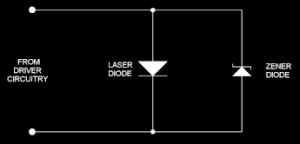ESD polarity terminology used on this web site
The term “positive-ESD” is used to mean electrostatic discharge (ESD) whose voltage polarity would tend to forward-bias a laser diode. “Negative-ESD,” means ESD whose voltage polarity would tend to reverse-bias a laser diode.
|
Review of ESD approaches |
||||
| START | PREV | CURRENT | NEXT | END |
|
Introduction << |
||||
Review of ESD approaches
Zener diode used as an ESD protection means
 The figure to the right shows another ESD protection means commonly employed to protect laser diodes. In this scheme, a Zener diode is connected anti-parallel with the laser diode. There are several problems with this technique.
The figure to the right shows another ESD protection means commonly employed to protect laser diodes. In this scheme, a Zener diode is connected anti-parallel with the laser diode. There are several problems with this technique.
One problem is that Zener diodes are notoriously slow devices, and are not able to react to nanosecond-level pulses that can be seen during ESD events.
The second, and more serious, problem is that it is believed to be impossible to choose a Zener voltage that is close enough to the forward-bias lasing threshold of the laser diode, and whose Zener voltage would track the laser diode’s lasing threshold voltage throughout temperature ranges likely to be experienced by a laser diode.
In our testing, we could not find a Zener diode that would protect a laser diode. We even tried Transient Voltage Suppressor (TVS) devices whose function is similar to a Zener diode, but are made specially to protect electronic devices from power surges. However, we did not find any TVS devices that were effective at protecting laser diodes either.
In fact, in our research we learned something very interesting about TVS devices. Most TVS devices were not designed to protect against ESD. They were designed to protect against lightning-induced power surges. Lightning itself can produce surges with very fast rise-times. But by the time lightning comes in contact with an electrical product, it is after having traveled through power distribution systems whose inductance, capacitance and resistance tends to spread out the event over tens of microseconds.
If you look at device datasheets you can find a clue as to which devices were designed to work with ESD, and which ones were designed to work with lightning and other surges. If the datasheet has a current specification with time specified as “8/20 microseconds”, chances are that the device was not designed to protect against ESD.

